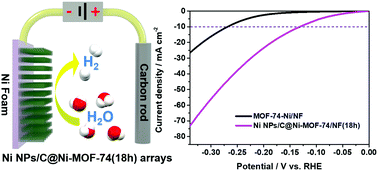Highly dispersed ultrafine Ni particles embedded into MOF-74 arrays by partial carbonization for highly efficient hydrogen evolution†
Abstract
Here, we report the successful fabrication of highly dispersed ultrafine Ni nanoparticles (NPs) embraced into the partially carbonized Ni-MOF-74 (Ni NPs/C@Ni-MOF-74) microrod arrays by the heat treatment of the rod-like Ni-MOF-74 arrays grown on Ni foam. The partial carbonization is an effective strategy to realize the homogeneous dispersion of ultrafine Ni NPs and carbon in the skeleton of rod-like Ni-MOF-74. This can prevent the encapsulated Ni NPs and carbon from aggregation and oxidation, allowing them to serve as highly efficient electrocatalysts. The fabricated Ni NPs/C@Ni-MOF-74 not only provide high specific surface area and high conductivity, but also provide good hydrophilicity and synergetic effects among Ni NPs, carbon and Ni-MOF-74 for the adsorption and activation of H2O molecules. The HER electrocatalytic performance of Ni NPs/C@Ni-MOF-74 arrays can be optimized by the control of the carbonization time and temperature. The optimized Ni NPs/C@Ni-MOF-74/NF shows outstanding HER catalytic performance, with a low overpotential of 131 mV at 10 mA cm−2 and excellent durability, and it is superior to most of the recently reported MOF-based HER electrocatalysts.

- This article is part of the themed collection: Popular Advances


 Please wait while we load your content...
Please wait while we load your content...